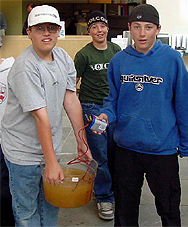Conservation and Analysis
Preserving artifacts for study
Preserving artifacts for study
 Students at the Ocean Institute learning to build electrolysis tanks--an important method for cleaning and conserving metal artifacts.
Students at the Ocean Institute learning to build electrolysis tanks--an important method for cleaning and conserving metal artifacts.Image from the Ocean Institute.
Probably not because the change in environment can be quite shocking to the artifact. Artifacts as well as family heirlooms, such as photographs and wedding dresses, need special handling and careful conservation if you want them to be in good shape many years from now.
Burial and time may not be kind to an artifact if it's preserved at all. Artifacts are often broken, corroded or covered with encrustations.
Archaeologists use special conservation techniques to improve the condition of objects as historical artifacts. For example, the parts of a broken object might be reassembled to get a better look at the entire object. Encrustations might be removed to reveal the artifact itself.
But there are many different conditions to correct and each one requires a special solution without causing further damage. Conservation techniques include processes that require hand application, chemical processes and more.
Donny Hamilton, one of the world's foremost underwater archaeologists has this to say about conservation in his manual Methods of Conserving Archaeological Material from Underwater Sites:
"Artifacts recovered from a salt water environment are often well preserved but of a very friable nature. In general, artifacts recovered from anaerobic marine environments (i.e., buried in sediment) are recovered in better condition than artifacts recovered from aerobic marine environments (i.e., the water column and surface sediment). Artifacts not properly conserved in a timely manner are apt to deteriorate at a very rapid rate and subsequently become useless as diagnostic or display specimens. Organic material, i.e., leather, wood, textile, rope, plant remains, etc., if allowed to dry without conservation treatment, can crumble and become little more than a pile of dust and debris in a matter of hours. Iron, on the other hand, can last for a few days to months according to the size and density of the artifact; however, it too will eventually deteriorate and become useless as a display or diagnostic specimen. Bone, glass, pottery, and similar material will, if not conserved, slowly devitrify and, in extreme cases, degenerate to a pile of worthless slivers. For these reasons, conservation must be of paramount concern when the excavation of a marine archaeological site is considered."
At the Ocean Institute
Students and visitors to the Ocean Institute can try removing their own encrustations.
On-line visitors can try the following methods at home or school:
Where to find more information:
Methods of Conserving Archaeological Material from Underwater Sites
Check out the many methods that archaeologists use to conserve artifacts from underwater archaeological sites. Originally developed as a lab manual to accompany the class, Conservation of Cultural Resources, at Texas A&M University. Content empahsizes conservation of materials from underwater archaeological sites.
Copyright 2000 by Donny L. Hamilton, Conservation Research Laboratory, Texas A&M University
Conservation of Artifacts
To learn more about conservation.
from Shipwreck!, a former exhibit at the Miami Museum of Science
Produced in collaboration with Scripps Institution of Oceanography.
Website by Earthguide.
© 2003-2004 by the Ocean Institute
and the Regents of the University of California.
All rights reserved.
Last modifed Monday, December 10, 2004
